When the cool December breeze starts to whisper through the streets of the Philippines, a sense of anticipation fills the air. It’s the time for Simbang Gabi, a tradition that lights up the archipelago with faith, food, and fellowship.
Let me take you on a journey that starts in the darkest hours of the morning, when stars are still twinkling like little lanterns in the sky. It’s 4 AM, and the neighborhood is buzzing with the sound of ‘puto bumbong’ steamers hissing and church bells tolling. Families wake up while the world is still draped in night’s velvet, their eyes heavy but hearts wide awake with excitement.
In the Philippines, Simbang Gabi is not just a series of masses; it’s a spiritual odyssey. For nine days, people from all walks of life make a commitment to wake up before the sun does. It’s a testament to their devotion, a sacrifice made sweeter by the promise of Christmas.
Imagine walking down the cobblestone streets, heading towards a church that has seen centuries pass by. The San Agustin Church in Manila, a UNESCO World Heritage Site, is one such church that comes to life during Simbang Gabi. Its doors open to reveal a sanctuary of history and spirituality, where the songs of the faithful have echoed since the 16th century.
Or perhaps you find yourself in the Visayas, at the Miagao Church in Iloilo. Its ornate limestone walls, etched with the history and artistry of the Filipino people, are a sight to behold as they stand against the backdrop of the early morning sky.
Here’s a fascinating fact: Did you know that attending Simbang Gabi is a testament to one’s commitment and faith? There’s a popular belief that if you complete all nine days, your heartfelt wish will be granted.
And as you walk into the Basilica Minore del Santo Niño in Cebu, you can’t help but be overwhelmed by the majestic blend of history and devotion. This church is not only one of the oldest in the Philippines but also home to the revered statue of the Santo Niño, which many believe to be miraculous.
In Pampanga, the lantern festival of San Fernando complements the Simbang Gabi experience. The giant lanterns, locally known as ‘parols,’ symbolize the Star of Bethlehem and are a spectacular sight that enhances the festive mood of the season.
Simbang Gabi culminates with Misa de Gallo on Christmas Eve, and there’s nowhere more iconic to attend this mass than at the Manila Cathedral. With its resplendent architecture, it’s a beacon of light, hope, and community, embodying the spirit of the season.
As you partake in the communal feast of ‘puto bumbong’ and ‘bibingka’ after the mass, you become part of a tradition that’s been cherished for generations. Simbang Gabi is not just about the dawn masses; it’s about the unity and resilience of the Filipino spirit.
So, to those who have never experienced this beautiful tradition, I invite you to imagine a world where the end of the year is not just about the hustle and bustle but about community, reflection, and a shared hope for the future. That’s the world of Simbang Gabi, a precious gem in the treasure chest of Filipino culture. Join us, under the starlit sky, and be part of a story that’s been told for generations, one dawn at a time.

